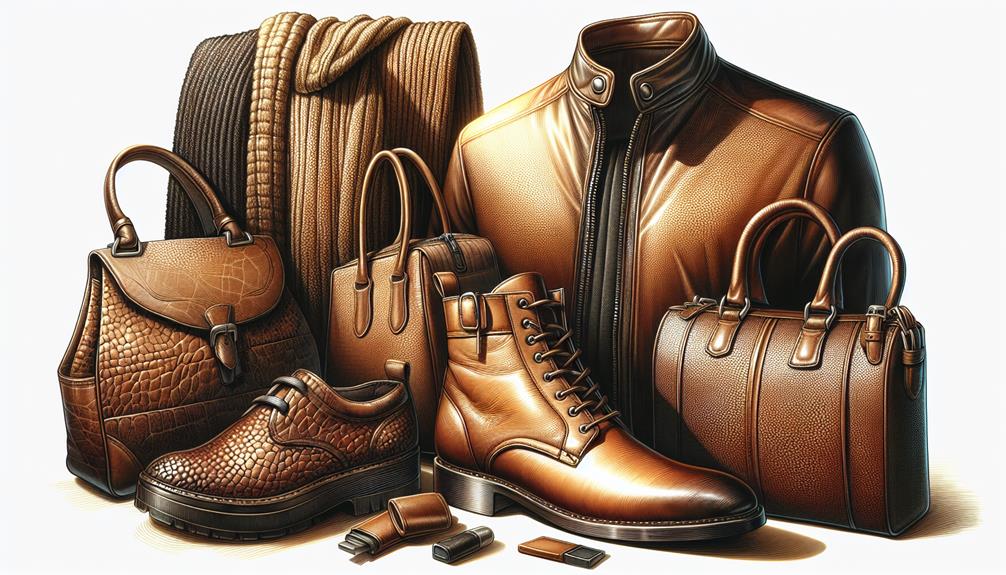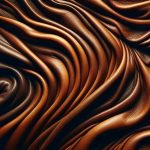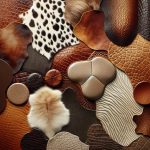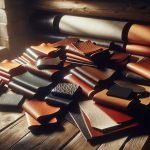I'd say the texture of leather really depends on the type you're handling. It can range from super smooth and soft to richly grainy or even pebbly. There's full grain which feels sturdy and natural because it retains the original textures of the animal skin. Then there's nubuck, which has a softer, velvety surface since it's been buffed. And don't forget about embossed leather that features patterns and designs, offering more variation. Each type has its own unique feel and quality, influenced by how it's finished, be it matte, satin, or glossy. Stick around, and you'll see there's a lot more to explore about leather textures.
Table of Contents
Key Takeaways
- Leather texture can range from ultra-smooth to deeply grainy, depending on finishing techniques.
- Traditional leather textures include smooth, grainy, and pebble-grain surfaces.
- Finishes such as matte, satin, or glossy can dramatically alter the tactile and visual appeal of leather.
- Embossing adds unique patterns and textures using heat and pressure.
- The quality and feel of leather are influenced by factors like grain size and treatment methods.
History of Leather Textures
Leather textures have transformed through the ages, evolving with each change in tanning methods and fashion demands. Initially, the textures of leather were directly tied to their practical applications. For instance, durability was crucial for making armor, influencing the development of tough, grainy textures that could withstand wear and tear.
As tanning techniques became more sophisticated, particularly during the Industrial Revolution, the variety of leather textures expanded dramatically. This period marked a significant shift, as innovations allowed for the mass production of different textures like smooth and pebble grain, which were previously harder to consistently achieve.
These advancements also reflected the changing fashion trends. Over time, as the need for armor declined, the demand for finer, more aesthetically pleasing textures grew. This shift wasn't just about looking good; it was about crafting identities and adhering to the social standards of the times.
Today, these traditional textures—smooth, grainy, and pebble grain—continue to be popular, but they're now optimized to suit modern preferences, blending historical techniques with contemporary innovations. This evolution shows how deeply intertwined leather's history is with human progress, both technologically and culturally.
Leather Texture Variations
Exploring the diverse world of leather textures, we find variations from the ultra-smooth to the richly grainy, each with its own unique appeal and purpose. When I delve into the texture of leather, it's fascinating to see how different types of leather finishing can dramatically alter its feel and appearance.
For instance, smooth leather offers a sleek, refined surface, making it a favorite for high-end accessories. It contrasts beautifully with the ruggedness of full grain leather, which retains the natural grain, including some imperfections, adding character and durability.
Nubuck leather, on the other hand, presents a soft, velvety texture that's irresistible to touch. This type of leather is sanded on the grain side, giving it a slight nap. It's quite different from embossed leather, where patterns are stamped into the surface to create a distinct texture, often mimicking exotic skins or intricate designs.
Moreover, patent leather shines with its glossy finish, standing out as a bold choice for fashion items. Each finish, whether matte, satin, or glossy, influences the tactile experience and aesthetic appeal of the leather, guiding my choices whether I'm shopping for durability, luxury, or a unique style statement.
Crafting Leather Textures
As we've seen the varied textures that leather can exhibit, let's now look at how these textures are meticulously crafted. The crafting process begins with selecting the right hide, followed by various methods like buffing, sanding, and especially embossing to achieve the desired leather texture.
Embossing is fascinating; it uses heat and pressure to imprint designs onto leather, creating anything from a smooth to a grainy texture. This technique can mimic exotic animal skins or intricate geometric patterns, which adds depth and character to the leather. Depending on the finish—matte, satin, or shiny—the texture can dramatically alter the leather's appearance and how it feels to the touch.
Leather finishes play a huge role too. A matte finish gives the leather a subdued, elegant look without extra shine, perfect for professional or understated items. In contrast, a shiny or glossy finish can enhance the texture, making it pop more visually and feel slicker.
Each step in the crafting process is crucial for achieving specific tactile qualities. Whether you're after a rugged, grainy texture for a casual bag or a sleek, smooth surface for a luxury wallet, understanding these techniques helps in creating a product that not only looks but feels just right.
Identifying Leather Quality
To determine the quality of leather, start by examining the grain's size and shape; coarse grains generally indicate a rougher texture, whereas fine grains are smoother to the touch. When I assess leather quality, I always focus on touch and feel. Full-grain leather, known for its superb leather durability, offers a dense grain pattern that enhances both breathability and water resistance.
Different textures in leather, such as pebbled or embossed, not only affect the aesthetic but also the practicality. For instance, smoother top grain leather mightn't be as durable as full-grain, but it often presents a more refined look. Each texture type has its own set of benefits, and understanding these can significantly aid in identifying leather quality.
The leather structure also plays a crucial role. Thicker leather means improved durability and often indicates high-quality material. By feeling the weight and thickness, you can get a good sense of the leather's quality. Always remember, good quality leather should feel sturdy yet flexible, offering a balance between protection and ease of use. Knowing these aspects helps me make educated choices when selecting leather goods based on expected performance and longevity.
Types of Leather Goods
Leather goods, ranging from stylish bags to durable shoes, showcase the versatility and timeless appeal of different types of leather. I've always been fascinated by how leather products, each with unique leather textures, serve various functions while enhancing style. For instance, the rugged texture of full-grain leather is perfect for high-quality leather jackets that can withstand wear and tear. Conversely, the smoother surface of top-grain leather is ideal for elegant handbags that make a fashion statement.
When selecting leather goods, understanding the nuances between leather types is crucial. Genuine leather, though not as durable as full or top grain, offers affordability with decent quality. Bonded leather, made from leftover scraps, is less durable but can be a cost-effective option for trendy accessories. Here's a quick breakdown of common leather products and their typical leather types:
| Leather Goods | Common Leather Types |
|---|---|
| Jackets | Full-grain |
| Handbags | Top-grain |
| Wallets | Genuine leather |
| Belts | Bonded leather |
Each type affects the quality of the leather and its suitability for different leather goods, directly influencing their longevity and appearance.
Caring for Leather Textures
Understanding the different types of leather helps me appreciate the importance of properly caring for their textures. Each texture of leather demands specific care routines to keep it looking and feeling great. I've learned that regular cleaning and conditioning are crucial. This not only maintains the quality and appearance but also ensures that the leather remains supple.
To care for my leather items, I avoid excessive exposure to sunlight and heat, which can really damage the texture, causing it to dry out and crack. Instead, I use specialized leather products designed for the specific type of leather I own. These products are formulated to safely clean and preserve without harsh chemicals that might harm the leather.
For daily maintenance, I stick to gentle brushing or wiping with a damp cloth. This simple step removes surface dirt and prevents buildup, which can affect the leather's texture over time. It's a quick, effective way to maintain the integrity of the leather without too much fuss.
Keeping these practices in mind allows me to enjoy my leather goods for years, ensuring they age gracefully and retain their unique textures. Caring for leather isn't just about upkeep; it's about preserving a piece of craftsmanship.
Environmental Impact of Leather
As I'm exploring the environmental impact of leather, it's clear that the production process isn't just about creating durable materials.
The pollution from tanning and the disruption to wildlife habitats are significant concerns.
It's crucial to consider how these practices affect our planet.
Leather Production Pollution
I'll start by explaining how the process of making leather significantly harms our environment. Leather production pollution mainly stems from tanneries releasing harmful substances like chromium and sulfides into our waterways, leading to serious water contamination. This not only affects aquatic life but also impacts the quality of drinking water for surrounding communities.
Additionally, the demand for cattle leads to deforestation and habitat destruction, exacerbating climate change. It's clear that the environmental impact of leather is severe. However, there's a silver lining as efforts are underway to adopt sustainable practices.
Developing eco-friendly alternatives can help mitigate these issues, aiming for a future where fashion doesn't come at the expense of our planet.
Wildlife Habitat Disruption
Leather production not only pollutes; it also significantly disrupts wildlife habitats. When we dive into the heart of the issue, it's clear that the demand for leather has far-reaching impacts on our environment. Here's a quick rundown:
- Deforestation and habitat destruction: Clearing forests for cattle grazing reduces natural habitats.
- Land degradation: Overgrazing and chemical spills harm the soil.
- Water pollution: Tanning chemicals pollute our waterways, affecting aquatic life.
- Endangered species: Many species lose their homes and struggle to survive.
- Biodiversity loss: Fewer natural areas mean less wildlife variety.
Each of these points highlights how interconnected and fragile our ecosystems are. The choices we make in fashion can ripple through nature in profound ways.
Frequently Asked Questions
What Is the Texture of Original Leather?
The texture of original leather varies widely. It can feel smooth, grainy, or somewhere in between, depending on the animal and tanning method. It's unique for each hide, impacting its look and feel.
How Would You Describe the Feeling of Leather?
I'd say leather feels luxurious, varying from silky smooth to distinctively grainy. Its texture adds character, whether it's soft and supple or rugged and matte, greatly influencing its look and feel in products.
What Is the Description of Leather?
Leather's description varies widely, but it generally feels supple and durable. It comes in many finishes, affecting both texture and appearance, from smooth and glossy to rugged and weathered.
What Is the Best Leather Texture?
I'd say the best leather texture is full-grain because it maintains the natural look and is extremely durable. It really suits my style and lasts long, making it perfect for everyday use.
- Is Tencel Cotton or Polyester? - April 20, 2024
- Does Tencel Make You Sweat? - April 20, 2024
- Does Tencel Lyocell Wrinkle Easily? - April 20, 2024







